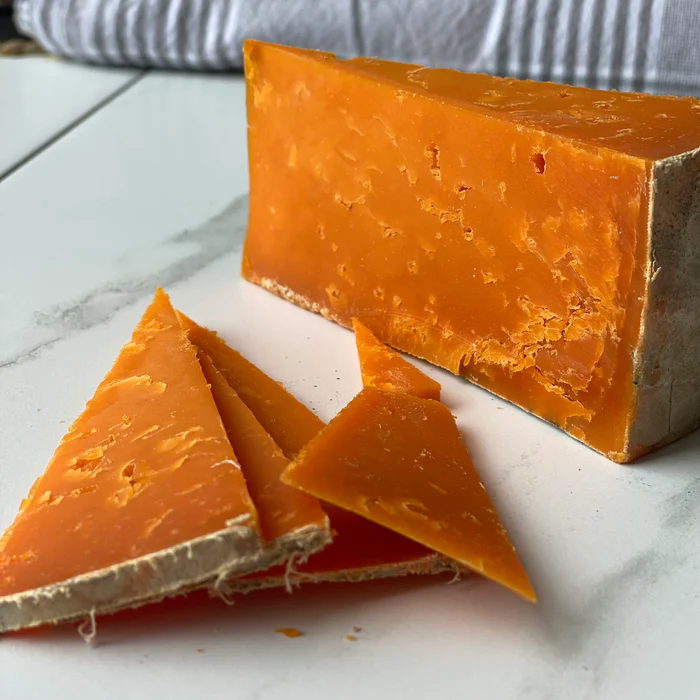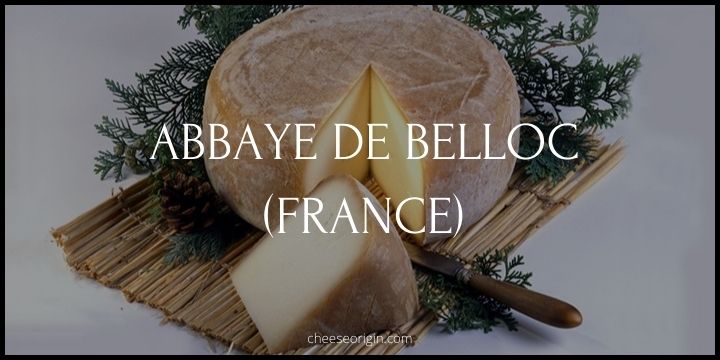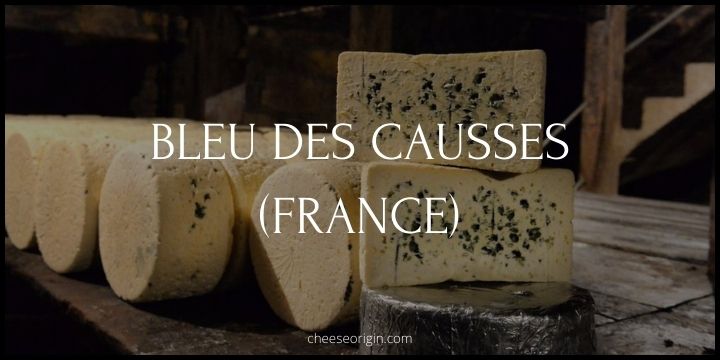What is Red Leicester? The Ruby of English Cheeses

Meet Red Leicester, the ruby of English cheeses. This vibrant, russet-hued delicacy is a classic British cheese with a history that dates back to the 18th century. Renowned for its striking color, which comes from the natural vegetable dye annatto, Red Leicester boasts a firm texture and a subtly sweet, nutty flavor.
When melted, it transforms into a silky, rich delight, making it a versatile choice for culinary creations. Whether you’re savoring it on its own or incorporating it into a dish, Red Leicester truly is a gem among cheeses.
Quick Facts About Red Leicester
| Fact | Detail |
|---|---|
| Origin | England |
| Made from | Cow’s milk |
| Cheese family | Hard |
| Ageing time | 6 months to 1 year |
| Texture | Firm and crumbly |
| Flavor | Nutty, mildly sweet |
| Color | Deep orange-red |
| Rind | Waxed |
| History | Traced back to the 17th century |
| Pairings | Ales, full-bodied red wines |
| Uses | Grating, melting, snacks |
| Specialty | Annatto seed gives it its distinctive color |
| Vegetarian | Yes, if made with vegetarian rennet |
| Availability | Year-round |
| Popular dishes | Red Leicester cheese toasties, mac and cheese |
| Storage | Cool, humid conditions; best consumed fresh |
What is Red Leicester?

Red Leicester, a treasure from the heart of England, is a hard cheese known for its distinctive deep orange-red color and crumbly texture. This cheese is a feast not only for your palate but also for your eyes. Its vibrant hue, derived from the natural annatto seed, sets it apart from other English cheeses and makes it a visually appealing addition to any cheese board.
The story of Red Leicester dates back to the 17th century, making it a piece of edible history. The cheese is made from cow’s milk and is typically aged between six months to a year, resulting in a firm texture that crumbles delightfully when sliced. Despite its firmness, Red Leicester is surprisingly creamy with a flavor profile that is nutty and mildly sweet, offering a taste that is as unique as its appearance.
What truly sets Red Leicester apart is its versatility in the culinary world. It can be enjoyed on its own, paired with a robust ale or a full-bodied red wine, or grated over pasta dishes for a rich and savory touch. Its superb melting quality also makes it a popular choice for toasties and macaroni and cheese.
In a world filled with cheeses of all kinds, Red Leicester stands out with its striking color, unique flavor, and rich history. Whether you’re a cheese connoisseur or a food enthusiast, this English cheese offers an experience that is sure to delight your senses.
What Does Red Leicester Taste Like?
Red Leicester possesses a nutty taste, which is complemented by a subtle sweetness. The cheese has a rich, savory depth with a slightly tangy finish that lingers on the palate. Despite its firm texture, Red Leicester has a creamy mouthfeel that enhances the overall tasting experience.
As the cheese matures, its flavor becomes more pronounced and intense, offering a robust taste that cheese lovers appreciate.
Red Leicester Tasting Notes
- Color: Deep orange-red, achieved by adding annatto seeds during the cheese-making process.
- Texture: Firm and crumbly, yet creamy in the mouth.
- Aroma: Mild and slightly sweet.
- Taste: A balance of nutty and sweet flavors, with a subtle tanginess.
- Aftertaste: Lingering savory notes that intensify as the cheese matures.
- Pairings: Complements robust ales and full-bodied red wines. Pairs well with fruits like apples and grapes.
- Culinary Uses: Excellent for grating over dishes, melting in sandwiches, or enjoying as a snack.
- Maturity: The flavor becomes more pronounced and intense with age, typically matured between 6 months to 1 year.
What is Red Leicester cheese used for?
- Vibrant Cheese Platters: With its striking red-orange hue, Red Leicester adds a pop of color to any cheese platter. Pair it with a variety of fruits, nuts, and bread for a delightful taste experience.
- Melted Delights: The cheese melts beautifully, making it perfect for gourmet grilled cheese sandwiches, quesadillas, or as a topping for your favorite burger, adding a rich, creamy, and tangy flavor.
- Culinary Creations: Its distinct flavor enhances the taste of pasta bakes, risottos, and potato dishes. Grate it over your dish before baking for a gorgeous golden crust.
- Gourmet Pairings: Savor the nutty and sweet flavors of Red Leicester with full-bodied red wines or robust ales. It also pairs well with apple cider for a refreshing contrast.
- Snacks and Appetizers: Slice it thin and serve with crisp apples or pears for a quick snack. Or cube it and serve with pickles and cold meats for an easy appetizer.
- Breakfast Treats: Grate Red Leicester into omelets, scrambled eggs, or on top of avocado toast for a savory breakfast treat. Its unique flavor can turn a simple breakfast into a gourmet meal.
- Dessert Pairings: For a unique dessert, pair slices of Red Leicester with sweet accompaniments like honey, fig jam, or dark chocolate. The balance of sweet and savory can be a delightful end to a meal.
- Cheese Fondue: Melt Red Leicester with other cheeses for a rich, flavorful fondue. The sweet and nutty notes of this cheese add depth to the fondue mix.
The possibilities are endless with Red Leicester cheese due to its versatility in both flavor and texture.
What is the Difference Between Red Leicester and Cheddar?
| Feature | Red Leicester | Cheddar |
|---|---|---|
| Origin | Originated in Leicestershire, England | Originated in the village of Cheddar, Somerset, England |
| Color | Deep orange-red, due to the addition of annatto seeds | Typically pale yellow, although some varieties may contain annatto for a deeper yellow or orange hue |
| Texture | Firm and crumbly, yet melts well and feels creamy in the mouth | Ranges from smooth and creamy (young Cheddar) to crumbly with a grainy texture (matured Cheddar) |
| Flavor | Sweet and nutty, with a mild tanginess | Starts off mellow in young Cheddar and develops into a strong, complex flavor in matured or aged Cheddar |
| Aging Process | Usually matured between 6 months to 1 year | Can be eaten young (2-3 months) or aged up to 2 years or more for sharp, robust flavors |
| Pairings | Pairs well with robust ales and full-bodied red wines, as well as fruits like apples and grapes | Versatile in pairings, goes well with a variety of beers, wines, fruits, and crackers |
| Uses | Excellent for grating over dishes, melting in sandwiches, or adding color and flavor to cheese boards | Extremely versatile – used in cooking (e.g., sauces, gratins, sandwiches), on cheese boards, or enjoyed on its own |
>> Click to read our in-depth guide on Cheddar
Red Leicester Nutrition Facts
| Nutrient | Amount per 100g |
|---|---|
| Calories | 416 kcal |
| Total Fat | 34.5g |
| Saturated Fat | 21.7g |
| Trans Fat | 0g |
| Cholesterol | 105mg |
| Sodium | 700mg |
| Total Carbohydrate | 1.3g |
| Dietary Fiber | 0g |
| Sugars | 0.5g |
| Protein | 25.4g |
| Vitamin D | 0.9µg |
| Calcium | 721mg |
| Iron | 0.4mg |
| Potassium | 98mg |
10 Best Red Leicester Substitutes
| Substitute | Description |
|---|---|
| Cheddar | A versatile cheese with a similar texture to Red Leicester. It can be used in a wide range of dishes. |
| Double Gloucester | Another English cheese, it has a similar flavor profile and is also colored with annatto, like Red Leicester. |
| Red Cheshire | Has a crumbly texture and a slightly tangy flavor. It’s a good substitute when color is important. |
| Colby | An American cheese with a mild flavor that’s similar to Red Leicester. It has a slightly softer texture. |
| Gouda | This Dutch cheese has a sweet and nutty flavor that can work well as a substitute for Red Leicester. |
| Edam | Another Dutch cheese, Edam has a milder flavor but can work well in recipes that call for Red Leicester. |
| Jarlsberg | This Norwegian cheese has a slightly sweet and nutty flavor. It melts well, making it a good substitute in cooking. |
| Emmental | A Swiss cheese with a mild flavor and good melting properties. |
| Mimolette | A French cheese that is similar in color to Red Leicester. It has a slightly stronger flavor. |
| Monterey Jack | An American cheese with a mild flavor and good melting properties. |
What Pairs Well With Red Leicester?

Food that goes well with Red Leicester:
| Category | Foods |
|---|---|
| Bread and Crackers | Whole grain bread, baguette, rye crackers, oatcakes |
| Fruits | Apples, pears, grapes, figs |
| Vegetables | Celery, bell peppers, cherry tomatoes |
| Meats and Fish | Salami, ham, smoked salmon |
| Condiments | Chutney, honey, mustard |
| Nuts and Seeds | Walnuts, almonds, pumpkin seeds |
| Desserts | Dark chocolate, fruit tarts |
Also read: 11 Best Crackers that Pair Well with Cheese
Beverage that goes well with Red Leicester:
| Category | Beverages |
|---|---|
| Wine | Cabernet Sauvignon, Merlot, Chardonnay, Rioja |
| Beer | Brown Ale, Stout, IPA (India Pale Ale) |
| Cider | Traditional Dry Cider, Pear Cider |
| Whisky | Single Malt Scotch, Irish Whiskey |
| Non-Alcoholic | Sparkling water, Apple Juice |
Also read: Best Wine and Cheese Pairings: The Ultimate Guide
Frequently Asked Questions
1. Is Red Leicester cheese strong?
Red Leicester cheese has a mellow, nutty flavor. It’s not as strong as some other types of cheese like blue cheese or aged cheddar. Its taste is often described as slightly sweet and savory. The aging process can affect the strength of the flavor, with longer-aged Red Leicester having a stronger taste than younger versions. However, even when it’s well-aged, its flavor is generally still fairly mild compared to many other cheeses.
2. Is Red Leicester good for melting?
Yes, Red Leicester cheese is good for melting. It has a similar texture to cheddar cheese and melts well without becoming too greasy. This makes it a popular choice for dishes like grilled cheese sandwiches, macaroni and cheese, and cheese sauces. Its vibrant orange color also gives a visually appealing look to melted cheese dishes.
Also read:
- What is Wensleydale? From Monks to Modern Creameries
- What is Truffle Cheese? Savoring the Richness
- What is Babybel? A Snack-Sized Cheese Journey
- What is Humboldt Fog? A Taste of California’s Coastal Pastures
- What is Brin d’Amour? The Corsican Cheese Delight
- What is Kefalotyri? The Salty Delight from Greece and Cyprus
- What is Rogue River Blue? America’s Award-Winning Cheese





